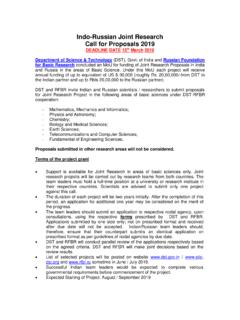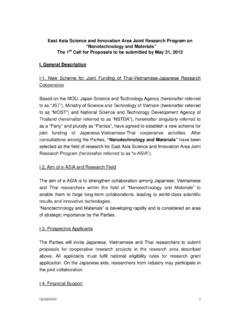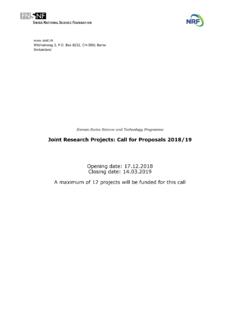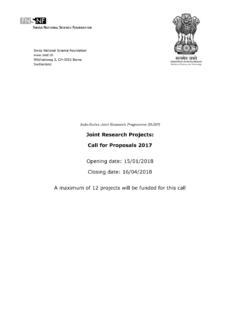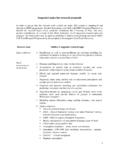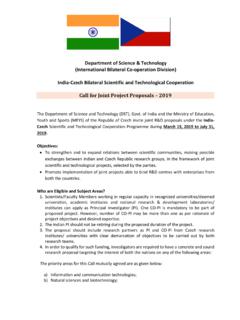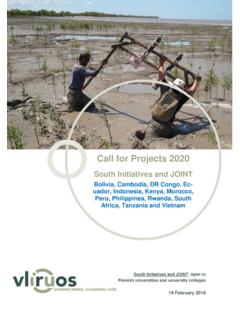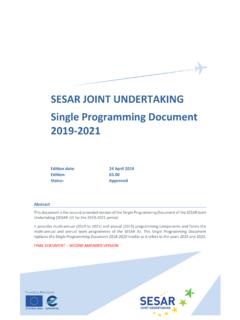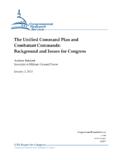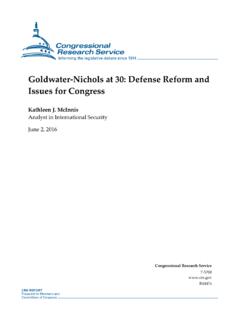Transcription of Interagency Collaborative Arrangements and Activities ...
1 Interagency Collaborative Arrangements and Activities : Types, Rationales, Considerations Frederick M. Kaiser Specialist in American National Government May 31, 2011. Congressional research Service 7-5700. R41803. CRS Report for Congress Prepared for Members and Committees of Congress Interagency Collaborative Arrangements and Activities Summary Interagency collaboration among federal agencies with overlapping jurisdictions and shared responsibilities is not a new phenomenon. Attempts to foster cooperation among agencies, reduce their number in particular policy areas, or clarify the division of labor among them date to the early days of the republic. Such Arrangements are increasing in the contemporary era in number, prominence, and proposals across virtually all policy areas. The reasons for the current upsurge are the growth in government responsibilities, cross-cutting programs, and their complexity.
2 Certain crises which showed severe limitations of existing structures; and heightened pressure to reduce the size of federal programs and expenditures. Recent congressional action reflects these considerations. In 2010, Congress directed the Government Accountability Office (GAO) ( 111-139, 124 Stat. 29) to conduct routine investigations to identify programs, agencies, offices, and initiatives with duplicative goals and Activities within Departments and governmentwide and report annually to Congress on the findings, including the cost of such duplication. GAO identified 34 such programs. The GPRA Modernization Act of 2010 ( 111-352). provides that the Office of Management and Budget's government-wide priority goals include outcome-oriented goals covering a limited number of crosscutting policy areas. Legislative initiatives in the 112th Congress have also advanced across-the-board reviews ( , 155) or recognize shared jurisdictions and responsibilities among agencies.
3 And House Rules for the 112th Congress call on its standing committees to include proposals in their oversight plans to eliminate programs that are inefficient, duplicative, outdated, or more appropriately administered by State or local governments. President Barack Obama has taken similar stands regarding overlapping programs in his 2011 State of the Union Address, subsequent memoranda, and recent budget requests and the executive has continued ongoing Arrangements or added new ones. The broad concept of Interagency collaboration contains at least six types of various Activities and Arrangements : collaboration (an exchange among relatively equal entities or peers, separate from collaboration's broad use), coordination, mergers, integration, networks, and partnerships. These categories often overlap with, supplement, or reinforce one another; and several different types may occur in the same organizational structure and endeavor.
4 Complicating matters, the different types are not defined in public laws or executive directives, even though required in some. Because of this and other reasons, the terms have sometimes lacked consistency and precision, have been used interchangeably, or have been applied to more than one category. Nonetheless, working definitions can be developed for the different types. All of these are surrounded by a number of rationales, intended to enhance collaboration, improve coordination, or clarify responsibilities and jurisdictions among agencies. The underlying objectives and expectations range from reducing policy fragmentation and mitigating competition among agencies, to enhancing efficiency and effectiveness, changing organizational and administrative cultures, and streamlining and improving congressional and executive oversight. Despite these appeals, concerns and questions have arisen over some of the rationales and their underlying assumptions as well as determining the success or failure of Interagency efforts.
5 This report . which will be updated as conditions dictate examines the burgeoning field of Interagency collaboration and presents a bibliography at the end, highlighting the broad subject as well as specific areas. Congressional research Service Interagency Collaborative Arrangements and Activities Contents Introduction ..1. Various Types and Understandings of Collaboration ..2. Broad Interpretation of Collaboration ..2. Different Types of Interagency Collaboration ..3. Distinguishing Between Collaboration and Examples of Collaboration ..7. Examples of Qualifications on the Distinction Between Collaboration and Coordination .. 11. Background of Relevant Efforts and Concerns .. 12. Heritage and Antecedents .. 12. Contemporary Developments .. 13. Rationales for Interagency 14. End or Reduce Policy Fragmentation .. 16. Improve Effectiveness in Policy Formulation and 17. Make Agencies Aware of Different Perspectives and 17.
6 Mitigate Conflict Among 17. Increase Agency Productivity .. 17. Enhance Efficiency, Reduce Redundancy, and Cut Costs .. 17. Heighten the Attention to and Priorities for Cross-Cutting 18. Change Organizational Cultures .. 18. Change Bureaucratic and Administrative Cultures and Methods of 18. Streamline and Improve Congressional and Executive 19. Concerns and Questions about the Rationales .. 21. Difficulties in Assessing the Success of Interagency Collaboration .. 23. Factors Affecting the Adoption, Evolution, and Impact of Collaborative 24. Conclusions and 26. Selective Bibliography on Interagency Collaboration .. 28. Overarching Studies on Interagency 28. Homeland Security Interagency 30. National Security Interagency Structure .. 31. Security Clearance Process Interagency 32. Miscellaneous Studies on Interagency Collaboration .. 33. Contacts Author Contact Information .. 34. 34. Congressional research Service Interagency Collaborative Arrangements and Activities Introduction Interagency coordinative Arrangements and Activities called for in public laws, executive orders, and administrative directives appear to be growing in number, prominence, and proposals throughout virtually all individual policy areas and across-the-board.
7 Underlying this growth are several developments: the increase in governmental responsibilities, cross-cutting programs, and their complexity; the inadequate preparation for and response to severe crises (in particular, the 9/11 terrorist attacks and the 2005 Gulf Coast hurricanes); and heightened pressure to reduce or consolidate federal programs and expenditures. This report examines formal Interagency Collaborative Arrangements and Activities , which are intended to enhance joint efforts and cooperation among independent federal agencies with shared responsibilities and overlapping The study examines the following: various types and understandings of Collaborative Activities and Arrangements , as well as related concepts of Interagency coordination, integration, mergers and reorganizations, networking, and partnerships;. background of relevant efforts;. rationales for Interagency collaboration and the problems these are designed to address.
8 Concerns and questions about the rationales;. difficulties in assessing Interagency collaboration success or failure; and factors affecting the adoption, evolution, and impact of Collaborative Activities and Arrangements . This Congressional research Service (CRS) study builds on and supplements an extensive collection of materials, covering various aspects of Interagency collaboration, current and past, which are cited in the bibliography at the end of the report. That compilation identifies analyses of different subject and policy areas as well as different types of Arrangements used among agencies. The relevant studies both current and historical come from congressional committees, CRS, executive branch entities, Government Accountability Office (GAO), governmental commissions, professional associations, and scholars. 1. This review examines neither informal Collaborative Arrangements (those operating without formal authorization, such as a public law, executive order, administrative directive, or memorandum of agreement) nor intra-agency endeavors (those falling exclusively within a department or agency).
9 Both of these have significantly different parameters and Arrangements to develop and enforce Collaborative ventures compared to formal cross-agency Arrangements . Informal Arrangements , even if large in number and relatively stable over time, still lack officially fixed memberships and responsibilities; informal ventures, moreover, are difficult to identify and describe authoritatively. Intra-agency Arrangements also differ importantly from Interagency ones, in large part because the authority and resources held by the head of an agency over his or her own domain are more comprehensive and substantial than those held by the head of one entity over other independent entities engaging in Collaborative enterprises. Congressional research Service 1. Interagency Collaborative Arrangements and Activities Various Types and Understandings of Collaboration Interagency collaboration as a way to enhance cooperation among agencies with shared responsibilities and overlapping jurisdictions has been used in at least two different ways: to mean a distinct type of activity and arrangement , or broadly to cover one or more other related types (coordination, networking, integration, mergers, and partnerships).
10 2. Broad Interpretation of Collaboration Representative of this latter view, the Government Accountability Office has adopted an encompassing characterization of collaboration for certain of its reviews: For the purposes of this report we use the term collaboration broadly to include Interagency Activities that others have variously defined as cooperation, coordination, . integration, or networking. We have done so because there are no commonly accepted definitions of these terms and we are unable to make definitive distinctions between these different types of Interagency GAO later added to this by defining collaboration' as any joint activity by two or more organizations that is intended to produce more public value than could be produced when the organizations act alone. 4 This broad interpretation which approaches the generic cooperation led to the discovery of hundreds of examples of Collaborative Activities , even within a specialized Other studies have estimated similar 2.










